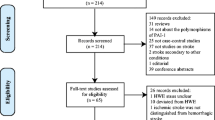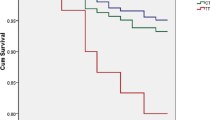Abstract
The 4G/5G polymorphism in the plasminogen activator inhibitor-1 (PAI-1) gene, has been associated with arterial disease. In this study, we investigated the association of IS in young patients with CRP and PAI-1 levels and frequency of insertion-deletion polymorphism of PAI-1 gene. The plasma levels of PAI-1 and CRP and the frequency of 4G/5G polymorphism were analyzed in 127 Brazilian young patients that presented IS and in 201 healthy and unrelated control subjects. The levels of CRP (P < 0.001) and PAI-1 (P < 0.001) were significantly higher in patients when compared with control group. Only PAI-1 plasma levels were independently associated with risk of IS (OR 3.40; 95% CI 1.49–7.74; P = 0.001) after adjustments for lifestyles covariates. The 4G/4G genotype was significantly more frequent among control subjects as compared to patients (OR 0.41; 95% CI 0.24–0.68; P < 0.001). Although increased PAI-1 plasma levels are associated with development of IS in Brazilian young patients, they are not influenced by the 4G/5G PAI-1 polymorphism.

Similar content being viewed by others
References
Song J, Yoon YM, Jung HJ, Hong SH, Park H, Kim JQ (2000) Plasminogen activator inhibitor-1 4G/5G promoter polymorphism and coagulation factor VII Arg353-->Gln polymorphism in Korean patients with coronary artery disease. J Korean Med Sci 15:146–152
Mansfield MW, Stickland MH, Grant PJ (1995) Plasminogen activator inhibitor-1 (PAI-1) promotor polymorphism and coronary artery disease in non-insulin-dependent diabetes. Thromb Haemost 74:1032–1034
Nowak-Göttl U, Sträter R, Kosch A et al (2001) The plasminogen activator inhibitor (PAI)-1 promoter 4G/4G genotype is not associated with ischemic stroke in a population of German children. Childhood Stroke Study Group. Eur J Haematol 66:57–62
Van Goor ML, Garcia EG, Leebeek F, Brouwers GJ, Koudstaal P, Dippel D (2005) The plasminogen activator inhibitor (PAI-1) 4G/5G promoter polymorphism and PAI-1 levels in ischemic stroke. A case-control study. Thromb Haemost 93:92–96
Sirgo G, Pérez-Vela JL, Morales P et al (2006) Association between 4G/5G polymorphism of the plasminogen activator inhibitor 1 gene with stroke or encephalopathy after cardiac surgery. Intensive Care Med 32:668–675
Catto AJ, Carter AM, Stickland M, Bamford JM, Davies JA, Grant PJ (1997) Plasminogen activator inhibitor-1 (PAI-1) 4G/5G promoter polymorphism and levels in subjects with cerebrovascular disease. Thromb Haemost 77:730–734
Heijmans BT, Westendorp RG, Knook DL, Kluft C, Slagboom PE (1999) Angiotensin I-converting enzyme and plasminogen activator inhibitor-1 gene variants: risk of mortality and fatal cardiovascular disease in an elderly population-based cohort. J Am Coll Cardiol 34:1176–1183
Roest M, van der Schouw YT, Banga JD et al (2000) Plasminogen activator inhibitor 4G polymorphism is associated with decreased risk of cerebrovascular mortality in older women. Circulation 101:67–70
Elbaz A, Cambien F, Amarenco P (2001) Plasminogen activator inhibitor genotype and brain infarction. Circulation 103:E13–E14
Endler G, Lalouschek W, Exner M, Mitterbauer G, Häring D, Mannhalter C (2000) The 4G/4G genotype at nucleotide position −675 in the promotor region of the plasminogen activator inhibitor 1 (PAI-1) gene is less frequent in young patients with minor stroke than in controls. Br J Haematol 110:469–471
Hindorff LA, Schwartz SM, Siscovick DS, Psaty BM, Longstreth WT Jr, Reiner AP (2002) The association of PAI-1 promoter 4G/5G insertion/deletion polymorphism with myocardial infarction and stroke in young women. J Cardiovasc Risk 9:131–137
Petrovic D, Milanez T, Kobal J, Bregar D, Potisk KP, Peterlin B (2003) Prothrombotic gene polymorphisms and atherothrombotic cerebral infarction. Acta Neurol Scand 108:109–113
Tuttolomondo A, Pinto A, Corrao S et al (2009) Immuno-inflammatory and thrombotic/fibrinolytic variables associated with acute ischemic stroke diagnosis. Atherosclerosis 203:503–508
House A, Dennis M, Mogridge L, Hawton K, Warlow C (1990) Life events and difficulties preceding stroke. J Neurol Neurosurg Psychiatry 53:1024–1028
Torres JL, Ridker PM (2003) Clinical use of high-sensitivity C-reactive protein for the prediction of adverse cardiovascular events. Curr Opin Cardiol 18:471–478
Sabino AP, De Oliveira Sousa M, Lima LM et al (2008) ApoB/ApoA-I ratio in young patients with ischemic cerebral stroke or peripheral arterial disease. Transl Res 152:113–118
Kohler HP, Grant PJ (2000) Plasminogen-activator inhibitor type 1 and coronary artery disease. N Engl J Med 342:1792–1801
Strickland S (2001) Tissue plasminogen activator in nervous system function and dysfunction. Thromb Haemost 86:138–143
Eitzman DT, Westrick RJ, Xu Z, Tyson J, Ginsburg D (2000) Plasminogen activator inhibitor-1 deficiency protects against atherosclerosis progression in the mouse carotid artery. Blood 96:4212–4215
Luttun A, Lupu F, Storkebaum E (2002) Lack of plasminogen activator inhibitor-1 promotes growth and abnormal matrix remodeling of advanced atherosclerotic plaques in apolipoprotein E-deficient mice. Arterioscler Thromb Vasc Biol 22:499–505
Heymans S, Luttun A, Nuyens D et al (1999) Inhibition of plasminogen activators or matrix metalloproteinases prevents cardiac rupture but impairs therapeutic angiogenesis and causes cardiac failure. Nat Med 5:1135–1142
Kinik ST, Atac FB, Verdi H, Cetintas S, Sahin FI, Ozbek N (2005) The effect of plasminogen activator inhibitor-1 gene 4G/5G polymorphism on glucose and lipid metabolisms in Turkish obese children. Clin Endocrinol 62:607–610
Ding J, Nicklas BJ, Fallin MD et al (2006) Plasminogen activator inhibitor type 1 gene polymorphisms and haplotypes are associated with plasma plasminogen activator inhibitor type 1 levels but not with myocardial infarction or stroke. Am Heart J 152:1109–1115
Rallidis LS, Gialeraki A, Merkouri E et al (2009) Reduced carriership of 4G allele of plasminogen activator inhibitor-1 4G/5G polymorphism in very young survivors of myocardial infarction. J Thromb Thrombolysis 29:497–502; Abstract
Hoekstra T, Geleijnse JM, Kluft C, Giltay EJ, Kok FJ, Schouten EG (2003) 4G/4G genotype of PAI-1 gene is associated with reduced risk of stroke in elderly. Stroke 34:2822–2828
Nagai N, de Mol M, Lijnen HR, Carmeliet P, Collen D (1999) Role of plasminogen system components in focal cerebral ischemic infarction: a gene targeting and gene transfer study in mice. Circulation 99:2440–2444
Carmeliet P, Moons L, Dewerchin M et al (1997) Insights in vessel development and vascular disorders using targeted inactivation and transfer of vascular endothelial growth factor, the tissue factor receptor, and the plasminogen system. Ann NY Acad Sci 811:191–206
Liberatore GT, Samson A, Bladin C, Schleuning WD, Medcalf RL (2003) Vampire bat salivary plasminogen activator (desmoteplase): a unique fibrinolytic enzyme that does not promote neurodegeneration. Stroke 34:537–543
Hankey GJ (2006) Potential new risk factors for ischemic stroke: what is their potential? Stroke 37:2181–2188
de Paula Sabino A, Ribeiro DD, Carvalho MG, Cardoso J, Dusse LM, Fernandes AP (2006) Factor V Leiden and increased risk for arterial thrombotic disease in young Brazilian patients. Blood Coagul Fibrinolysis 17:271–275
Acknowledgments
Authors are grateful to CNPq, FAPEMIG and CAPES for sponsoring this investigation.
Author information
Authors and Affiliations
Corresponding author
Rights and permissions
About this article
Cite this article
de Paula Sabino, A., Ribeiro, D.D., Domingueti, C.P. et al. Plasminogen activator inhibitor-1 4G/5G promoter polymorphism and PAI-1 plasma levels in young patients with ischemic stroke. Mol Biol Rep 38, 5355–5360 (2011). https://doi.org/10.1007/s11033-011-0687-4
Received:
Accepted:
Published:
Issue Date:
DOI: https://doi.org/10.1007/s11033-011-0687-4




